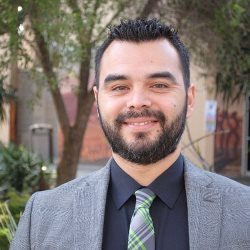If you’ve ever looked around at your or your child’s college professors — or at your colleagues, as the case may be — you might have noticed something looking right back at you: the yawning expanse of the diversity desert in faculties around the nation.
 Dr. Jason Rivera
Dr. Jason Rivera“Where are all the professors of color?” you might ask yourself. “Is it really that hard to hire a more diverse faculty?”
Actually, it really is that hard, and it’s a phenomenon that affects colleges across the country. To figure out why, start here: White students are 10 times more likely to earn a Ph.D. than Black students and 12 times more likely than Latino students. So what this means is that, of the 1.3 million professors working in American college and university faculties, most of whom have earned a Ph.D., only 6.7 percent are Black and 4.4 percent are Latino (2013). (It’s actually worse for private, nonprofit baccalaureate colleges, with only 5.3 percent Black faculty and 3.3 percent Latino.)
Circle back several years and we find that Black and Latino students have significantly lower high school graduation rates than their White counterparts, and Black and Latino students who go to college are more likely than White students to require some level of remedial coursework.
So, now we’re back to square one and need to ask, “Why are those students of color who aren’t becoming college professors not even graduating from high school or struggling once they do?”
To crystalize the answer, look no further than the “resource gap.” It’s the chasm between students who thrive and students who don’t, populated by woefully underfunded schools and the ghosts of essential resources students need to thrive, such as AP courses or, worse yet, textbooks. It exists in many communities — surviving on a steady diet of race-borne poverty — and serves as an aggressive barrier to the American dream.
it’s a people issue as well: Students attending underresourced schools too often don’t have counselors to push them to apply for college, let alone help them with college applications. Fewer role models are also present for students whose parents and relatives may not have graduated from high school because of that exact same, multigenerational resource gap.
Race and class are heavily intertwined in America, and no one is suggesting that poor White students don’t suffer from similar issues of underresourced schools. They do. But poor students of color, despite continual calls for multiculturalism and inclusion, still face ever-present, systemic racism that poor White students never will experience, making an already uphill educational climb that much steeper.
And what happens when students make the climb, defying the odds and land in a college classroom to find that only a small percentage of their professors are of color? The cascade — from low graduation rates to low rates of Ph.D.s to low rates of professors of color — comes to an end with students of color standing in that diversity desert of the American college classroom, wondering if maybe they really are out of place in higher ed. It’s the exact opposite of the ideal outcome, and it provides an unwelcome twist to an already fraught and complicated educational journey.
So let’s fill the resource gap and give students of color a fighting chance. With proper funding and resource allocation, we’ll one day be able to circle back and explore the reasons these students have been thriving at all levels of education, in roles across the spectrum, instead of the reasons they’ve been struggling to keep pace.
Dr. Jason Rivera is director of institutional research at Dickinson College. Previously, he served as director of institutional research at Pitzer College.





















